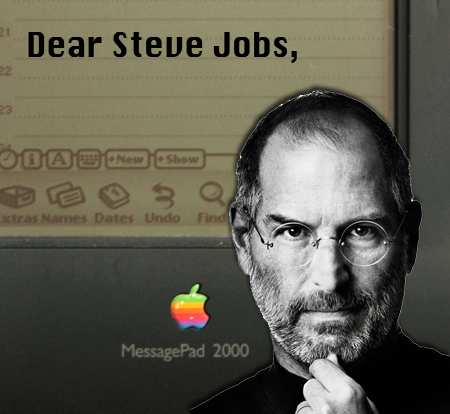Valentine to Steve Jobs, from the Newton community
February 14th, 2009
The Newton 2010 bug is rearing its ugly head again – this time prompting some Newton users to draft a petition to Apple asking for the release of Newton code to fix the problem.
But would a petition work?
It started on the Newtontalk list, after BobR posted a few experiments trying to see if his Newtons were affected by the 2010 bug. Then matthiasm posted a draft petition to the group, asking Steve Jobs to release Newton code to the community.
Newton users seemed to fall into two groups: one excited about the idea of lobbying Apple, and the other thinking the petition was a waste of time. The latter group seemed to think that focusing on the software and finding a fix was the most important to-do before 2010 hits.
Matt Howe (a tried-and-true Newton developer) thinks a petition is at least worth a shot:
I agree that there is a small chance this will work. I don’t believe that a petition of 100,000 signatures would move Steve Jobs to do something. And I agree that he may not even be in a position to help. But, that does not mean we should not try. People have been trying to bury the Newton line even before it went out of production. And since Apple killed it we have been considered a quaint oddity. But we know how hard we and those before us have worked to continue the platform. This is the least we can do to perpetuate little green friends.
Unfortunately, I can’t speak much to the coding side of things – for that, I would recommend checking out Tony Kan’s description of what’s needed to fix the bug.
But I will say that I agree with both sides of the argument: the software needs to be fixed, and the Newton community needs to ask Apple for some assistance. What can it hurt?
Newton users have an interesting relationship with the rest of the Apple and Mac community. There are some, like Leander Kahney, who give us a bit of respect for hanging on to our forgotten MessagePads. Meanwhile, other jackasses relegate our community to “weirdo” status, and tell us to give up our “dead” platform.
It feels like there is some sympathy to our cause, somewhere out there, and that’s why I think a big PR push – a petition, a big-name signatory (Woz?), a comprehensive engagement of the Mac media – could help. Draw attention to our plight, while the software wonks try to fix things on the back-end.
A combination of approaches seems best. After all, we’ve only got a year or so before things start really getting weird. If the Newton community doesn’t find a solution soon, our beloved Newts may become extinct next New Year’s.
matthiasm’s request – that Apple release some Newton code as they did with older versions of the Mac OS, an open-source version of Newton Toolkit, and some ROM source code – seems modest enough. Plus, Apple could score big warm-and-fuzzy points through publicity. The problem? They won’t make any money off this project.
And with Steve Jobs out for the foreseeable future, any petition or letter-writing campaign would need to reach the right people.
The important thing is to do something, and I think the best approach is to try all approaches. Hit Apple with some petitions, get the media to publicize our cause, draw some attention to the 2010 bug, and have smarter people than me work on the patch.
Who’s with me?






